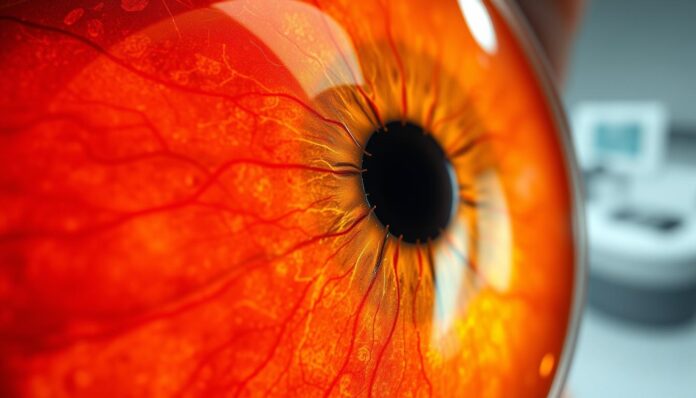Managing diabetes properly is essential to maintain good eye health. Diabetic retinopathy, a common complication of diabetes, can lead to vision loss if not treated early. Knowing the symptoms, diagnosis, and management options is crucial for protecting your sight while managing diabetes effectively.
Keeping your blood sugar under control is the most important factor in preventing diabetic eye disease. By maintaining healthy blood sugar levels and adopting a healthy lifestyle, you can lower the risk. Look out for warning signs like blurred vision, floaters, or blind spots. If you experience these, make sure to consult with a healthcare provider immediately.
Table of Contents
Key Takeaways
- Diabetic retinopathy can cause vision loss if not managed correctly.
- Blood sugar control is essential to prevent or slow down the progression of this condition.
- Common symptoms include blurred vision, floaters, and blind spots.
- Regular eye exams are critical for early detection and treatment of diabetic eye disease.
- A healthy lifestyle, including a balanced diet and exercise, can help reduce the risk of diabetic retinopathy.
- Seeking medical advice promptly if symptoms appear can help preserve your vision and maintain eye health.
Understanding Diabetic Retinopathy and Its Impact on Vision
Understanding how diabetic retinopathy affects the retina is key to managing the disease. This condition damages the blood vessels in the retina, which can lead to vision loss over time. Unfortunately, the early stages of diabetic retinopathy often don’t show any obvious symptoms, making regular eye exams even more important for individuals with diabetes.
Symptoms can range from mild vision disturbances to complete blindness, making early detection and intervention crucial. Be proactive in protecting your vision by undergoing routine eye exams and catching potential issues before they worsen.
Common vision problems caused by diabetic eye disease include:
- Blurred vision
- Floaters or flashes
- Dark spots or holes in your vision
- Loss of peripheral vision
Working closely with your healthcare provider and ophthalmologist helps in managing the disease and avoiding permanent damage to your eyesight.
Common Signs and Symptoms to Watch For
Knowing the early signs of diabetic retinopathy can help you prevent further vision damage. By keeping your blood sugar levels in check and adopting healthy habits, you can greatly reduce the likelihood of developing significant eye problems.
Here are some common symptoms:
- Blurred vision
- Floaters (tiny spots or threads in your field of vision)
- Double vision
- Vision loss
If you notice any of these signs, it’s important to seek medical attention immediately. Early detection of diabetic retinopathy is crucial for effective treatment and preserving your sight.
Diagnostic Tests and Procedures
To diagnose diabetic retinopathy, an eye exam is essential. It often involves various tests such as visual acuity tests, pupil dilation, and Optical Coherence Tomography (OCT). These help assess the health of the retina and detect any potential damage caused by diabetes.
Regular eye exams are vital, as diabetic retinopathy can progress without any noticeable symptoms in its initial stages. The primary tests for diagnosing diabetic eye disease include:
- Visual acuity test: Measures how well you can see.
- Pupil dilation: Enlarges the pupils to allow a more thorough examination of the retina.
- Optical Coherence Tomography (OCT): Provides detailed images of the retina.
Routine exams help catch diabetic eye disease early, allowing for timely intervention and minimizing the risk of vision loss.
Treatment Options for Diabetic Retinopathy
The goal of treating diabetic retinopathy is to stop or slow down the damage to the retina and prevent further vision loss. Laser treatment is a common method used to reduce swelling and protect the retina’s blood vessels. This treatment helps control the condition and prevent worsening symptoms.
For more advanced cases, surgery may be needed to remove blood or scar tissue from the retina. Maintaining proper blood sugar levels and a healthy lifestyle are also essential parts of the treatment plan.
Common treatment methods include:
- Laser photocoagulation: Reduces swelling and prevents further damage.
- Vitrectomy: A surgical procedure that removes blood and scar tissue from the retina.
- Medications: Used to reduce inflammation and prevent further damage to blood vessels in the eye.
Consulting with your healthcare provider helps in determining the best treatment options suited to your individual needs.
Lifestyle Changes to Protect Your Vision
Lifestyle changes play a significant role in managing diabetic retinopathy and protecting your vision. A healthy lifestyle can help prevent the progression of diabetic eye disease and improve your overall well-being. This includes maintaining a balanced diet, exercising regularly, and quitting smoking.
Key lifestyle modifications include:
- Eating a healthy, balanced diet with plenty of fruits, vegetables, whole grains, and lean proteins.
- Staying active: Regular physical activity helps manage blood sugar levels and improve overall health.
- Staying hydrated and managing stress levels.
In addition, regular eye exams are crucial to ensure that any issues with your vision are detected early.
Prevention Strategies and Risk Reduction
Preventing diabetic retinopathy involves not only controlling your blood sugar levels but also managing your blood pressure and cholesterol. Regular exercise, a healthy diet, and avoiding smoking can significantly reduce your risk of developing diabetic eye disease.
Important prevention strategies include:
- Monitoring your blood sugar regularly.
- Attending regular eye exams to catch potential issues early.
- Maintaining a healthy weight and living a balanced lifestyle.
- Controlling blood pressure and cholesterol levels.
By following these strategies, you can lower your risk of diabetic retinopathy and protect your vision in the long term.
Conclusion:
If you have diabetes, taking control of your eye health is essential for preserving your vision. Understanding diabetic retinopathy, recognizing its symptoms, and managing the disease effectively can significantly reduce the risk of vision loss. Regular eye exams, blood sugar control, and adopting a healthy lifestyle are all key components of maintaining eye health.
By staying proactive in your diabetes management and eye care, you can live well and protect your vision from the effects of diabetic retinopathy.
FAQ Section
- What is Diabetic Retinopathy?
Diabetic retinopathy is an eye condition caused by high blood sugar levels that damage the blood vessels in the retina, leading to potential vision loss if not treated. - What are the symptoms of Diabetic Retinopathy?
Symptoms include blurred vision, floaters, vision loss, and difficulty seeing at night. - How is Diabetic Retinopathy diagnosed?
An eye doctor performs a comprehensive exam, including visual acuity testing, pupil dilation, and Optical Coherence Tomography (OCT) to detect the condition. - What are the treatment options?
Treatment may include laser therapy, surgery, and medications to manage symptoms and prevent further vision loss. - How can I prevent or manage Diabetic Retinopathy?
Control your blood sugar, maintain a healthy lifestyle, and attend regular eye exams to manage and prevent diabetic retinopathy. - Why are regular eye exams important for diabetics?
Early detection of diabetic eye disease can prevent permanent vision damage and help manage the condition effectively. - How can I take control of my eye health?
Stay informed, undergo routine eye exams, maintain good diabetes management, and live a healthy lifestyle to protect your vision.
Main References: National Library of Medicine



























